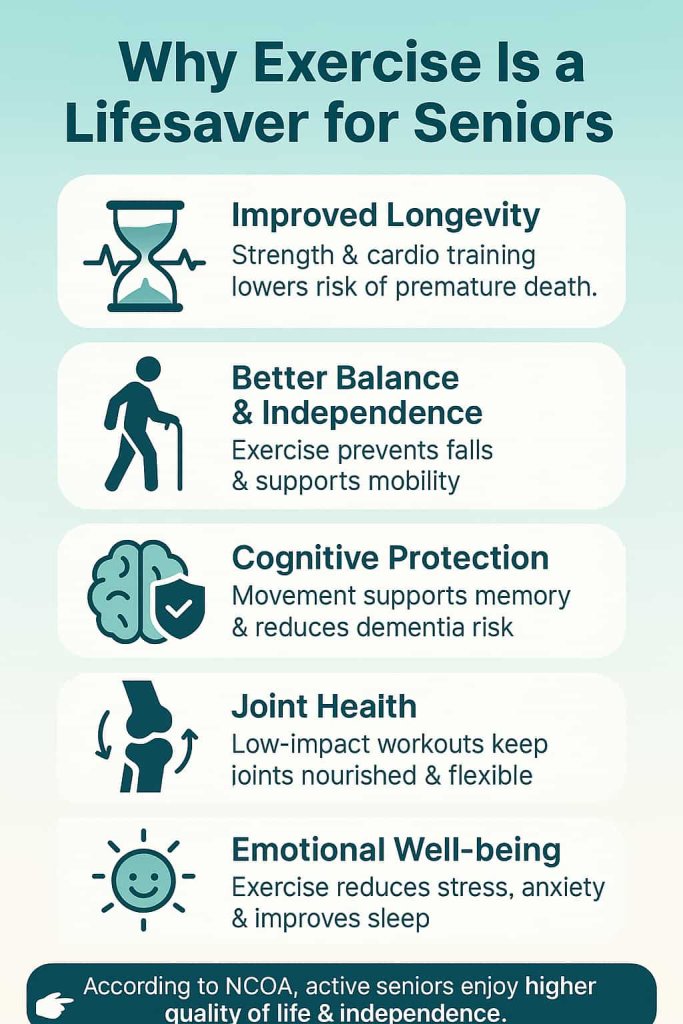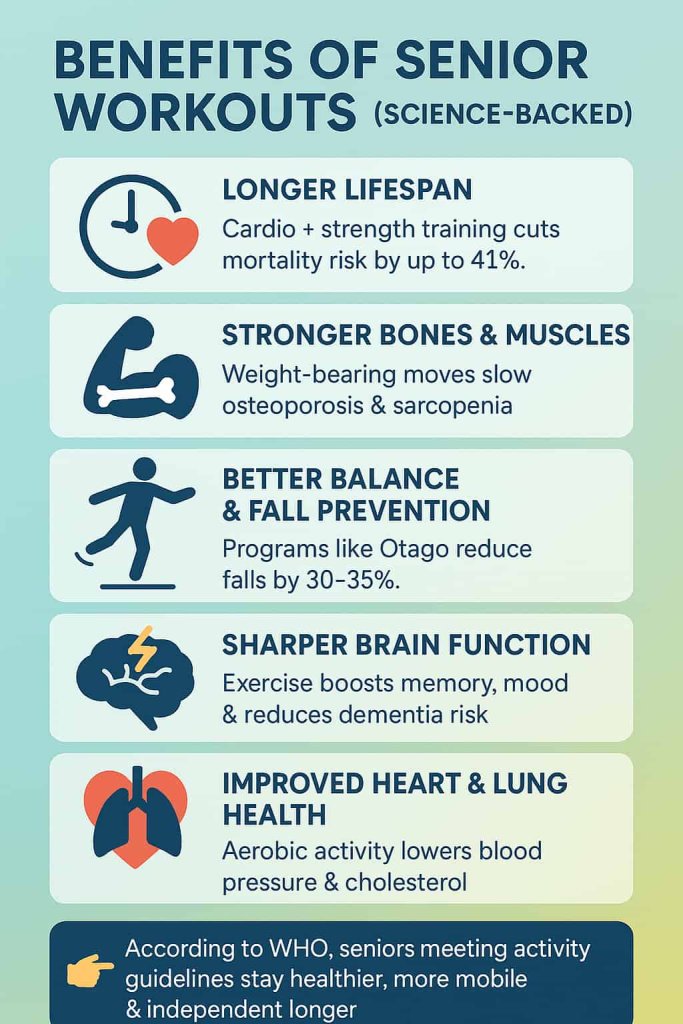Yes, the best exercises for seniors can dramatically improve strength, balance, and independence—without being complicated or unsafe. Regular movement is one of the most powerful tools older adults have to stay healthy, mobile, and confident.

Exercise is especially important for seniors because it combats age-related muscle loss (sarcopenia), improves bone density, protects against chronic disease, and even enhances brain health. According to the CDC (2024), seniors who consistently engage in strength training lower their mortality risk by 10–20%, while those who combine strength and cardio cut their risk by up to 41% (Barron’s, 2025).
This guide covers 15 best exercises for seniors—complete with benefits, tips, and evidence-backed insights—that you’ll wish you had started years ago.
Why Exercise Is a Lifesaver for Seniors
As we age, the body naturally loses muscle and bone density, leading to weakness, stiffness, and higher fall risk. But regular exercise slows or even reverses many of these changes. Here’s why it matters:

- Improved Longevity → Consistent strength + aerobic training dramatically lowers risk of premature death.
- Better Balance & Independence → Prevents falls, a leading cause of disability in older adults.
- Cognitive Protection → Exercise supports brain health and reduces dementia risk.
- Joint Health → Low-impact movement keeps cartilage nourished and flexible.
- Emotional Well-being → Regular workouts reduce anxiety, depression, and improve sleep.
👉 According to the NCOA, active older adults enjoy higher quality of life, fewer hospital visits, and more independence (NCOA, 2024).
15 Best exercises for Seniors
15 Best Senior exercises are safe, low-impact, and science-backed to improve strength, balance, flexibility, and cardiovascular health. Studies show regular exercise helps older adults reduce fall risk, preserve independence, and live longer, healthier lives.
1. Brisk Walking
Walking remains the king of senior cardio. Just 20–30 minutes most days strengthens the heart, lowers blood pressure, and burns calories.
How to Do It:
- Start slow, then increase pace to a brisk but comfortable level.
- Walk outdoors for fresh air or on a treadmill for safety.
Trainer Tip: Swing your arms to engage the upper body.
2. Water Aerobics
Water reduces stress on joints, making it perfect for arthritis or hip/knee pain. The resistance of water also strengthens muscles gently.
Benefits: Improves cardiovascular health, endurance, and flexibility—all without impact stress.
Example: Water jogging, flutter kicks, or aqua Zumba.
3. Chair Yoga
Chair yoga modifies traditional yoga to be seated or supported, making it safe for older adults with balance issues.
Why It Works: Increases flexibility, posture, core strength, and reduces stress.
Pro Tip: Focus on deep breathing alongside gentle stretches.
4. Resistance Band Training
Resistance bands are portable, inexpensive, and excellent for full-body workouts.
How to Do It:
- Perform bicep curls, rows, squats, and chest presses with bands.
- Aim for 2–3 sessions a week with 10–15 reps per set.
👉 According to MedlinePlus, resistance training reduces fall risk and strengthens bones in seniors.
5. Bodyweight Strength Moves
Your body is the best equipment you have. Exercises like wall push-ups, sit-to-stands, mini lunges, and glute bridges build practical strength.
Why It Matters: Supports daily tasks like getting out of chairs, climbing stairs, and carrying groceries.
6. Kettlebell Training
Often overlooked, kettlebells build grip strength, balance, and core stability.
Evidence: A 2025 study found kettlebell training in adults 60–80 improved mobility and reduced inflammation (Verywell Health, 2025).
Starter Move: Kettlebell deadlifts with a light weight.
7. Low-Intensity Interval Training (LIIT)
Gentle interval training alternates between slower and slightly faster walking or cycling.
Why Seniors Love It: Builds stamina without overexertion and is easier on the joints.
Routine: 2 minutes slow walking → 2 minutes brisk → repeat 4–5 times.
8. Adapted HIIT
High-Intensity Interval Training (HIIT) is possible for seniors if modified. Short bursts of higher effort followed by longer rests help strengthen the heart.
Harvard Health confirms that HIIT—done safely—boosts aerobic capacity even in seniors (Harvard, 2024).
Example: 20 seconds brisk walk → 60 seconds slow walk → repeat 5 times.
9. Seated Hip Abductions
A simple, physiotherapist-approved move that strengthens hips and glutes.
How to Do It:
- Sit tall with a band around thighs.
- Push knees outward and return slowly.
Benefit: Improves walking form and reduces fall risk (Tom’s Guide, 2025).
10. Otago Fall Prevention Program
A set of balance and strength exercises (often with ankle weights) proven to cut fall risk by 30–35% in older adults (Fall Prevention).
Exercises Include:
- Side leg raises
- Heel-to-toe walking
- Sit-to-stand drills
11. Tai Chi
Known as “meditation in motion,” tai chi improves balance, coordination, and mindfulness.
Why It Works: Strengthens stabilizing muscles while calming the mind.
Trainer Tip: Join a class for guided practice—it’s safer and more enjoyable.
12. Dance Workouts
From ballroom to Zumba, dancing is a fun way to improve coordination, cardiovascular health, and memory.
Extra Benefit: Social interaction keeps mood high and combats loneliness.
13. Ankle Weight Strengthening
Adding light ankle weights during seated leg lifts or walking strengthens legs and prevents muscle loss.
Pro Tip: Start with 1–2 lbs and never sacrifice form for load.
14. Core Stability Workouts
A strong core prevents falls and supports posture.
Best Senior-Friendly Options:
- Modified planks (on knees)
- Bird dogs (hands and knees, extend opposite arm and leg)
Benefit: Reduces back pain and supports daily mobility.
15. Daily Stretching Routine
Stretching keeps joints mobile and prevents stiffness.
What to Include:
- Neck rolls
- Shoulder circles
- Hamstring stretches
- Calf stretches
Tip: Stretch after workouts when muscles are warm.
Sample Weekly Workout Plan for Seniors
Here’s a safe structure that balances all four types of exercise:
| Day | Workout | Focus |
|---|---|---|
| Mon | Brisk walk + light band training | Cardio + strength |
| Tue | Chair yoga + core stability | Flexibility + balance |
| Wed | Water aerobics or dancing | Cardio + fun |
| Thu | Resistance bands + Otago program | Strength + fall prevention |
| Fri | Brisk walk or LIIT session | Cardio + endurance |
| Sat | Tai chi + stretching | Balance + recovery |
| Sun | Rest or light walking | Active recovery |
Benefits of Senior Workouts (Science-Backed)
Adding structured exercise to your weekly routine unlocks life-changing results. Here are the science-backed benefits seniors can expect:

- Longer Lifespan → Combining cardio and resistance workouts lowers risk of death from all causes by up to 41%.
- Stronger Bones & Muscles → Weight-bearing exercises slow osteoporosis and combat sarcopenia.
- Better Balance & Fall Prevention → Programs like Otago cut fall risk by 30–35%.
- Sharper Brain Function → Regular movement improves memory, reduces dementia risk, and enhances mood.
- Improved Heart & Lung Health → Aerobic activities like brisk walking lower blood pressure and cholesterol.
- Independence in Daily Life → From climbing stairs to carrying groceries, seniors maintain freedom longer.
👉 According to the World Health Organization, older adults who meet activity guidelines are healthier, more mobile, and live independently well into their 80s and beyond.
Safety Tips for Seniors
- Always warm up and cool down for 5–10 minutes
- Use chairs, rails, or walls for support if needed
- Breathe continuously—never hold your breath during lifts
- Stop immediately if you feel pain, dizziness, or chest discomfort
- Consult your doctor before starting a new workout plan
Common Mistakes Seniors Should Avoid
Even the best workout plan can backfire if you make these common errors:
- Skipping Warm-ups or Stretching → Cold muscles are more prone to injury. Always ease in.
- Lifting Too Heavy, Too Soon → Progress slowly—form and safety matter more than weight.
- Ignoring Balance Training → Most seniors focus on cardio but forget stability, leading to falls.
- Overtraining Without Rest → Recovery is just as important as the workout itself.
- Holding Your Breath During Strength Moves → This can spike blood pressure—always breathe steadily.
- Doing Only One Type of Exercise → A balanced routine (strength + cardio + balance + flexibility) delivers the greatest health benefits.
- Not Listening to Pain Signals → Discomfort can be normal, but sharp or persistent pain is a warning sign.
👉 Avoiding these mistakes keeps workouts safe, enjoyable, and sustainable for the long term.
FAQs About Senior Workouts
1. Is strength training safe for seniors?
Yes. Strength training improves bone density, muscle mass, and balance. Studies show it reduces fall risk by up to 30% (CDC).
2. How much exercise do seniors need weekly?
At least 150 minutes of moderate cardio or 75 minutes of vigorous cardio plus 2 sessions of strength training (WHO, 2024).
3. What’s the best exercise for arthritis?
Low-impact options like water aerobics, chair yoga, or LIIT walking are safest.
4. Can seniors do HIIT?
Yes, if adapted. Use short bursts of effort with longer rest (Harvard Health).
5. Do I need equipment?
Not at all—many routines use just your bodyweight or a chair. Bands and light dumbbells can help progress further.
6. How fast will I see results?
In as little as 2–4 weeks, expect more energy and mobility. Strength and balance improvements continue with consistency.
7. What’s the #1 goal for senior workouts?
Not just aesthetics—it’s about staying independent, strong, and safe.
Conclusion
The best exercises for seniors are those that combine strength, balance, flexibility, and cardiovascular health—all while staying safe and low-impact. From walking and resistance bands to yoga and fall-prevention programs, each routine plays a role in helping older adults stay strong, mobile, and independent.
It’s never too late to move better, feel stronger, and protect your health. By combining strength, cardio, flexibility, and balance exercises, you’ll build the foundation for a long, independent, and fulfilling life.
👉 Start today with one or two exercises from this list and gradually expand your routine—you’ll be amazed how quickly your body adapts.
References
- CDC – Growing Stronger: Strength Training for Older Adults
- Harvard Health – HIIT Workouts for Older Adults
- Verywell Health – Kettlebell Workouts for Older Adults
- NCOA – Benefits of Exercise After 60
- NHS – Physical Activity Guidelines for Older Adults
- clevelandclinic — low-intensity-interval-training
- Barron’s – Weightlifting & Aerobic Benefits
- Wikipedia – Fall Prevention (overview)
- MedlinePlus – Exercise for Older Adults
